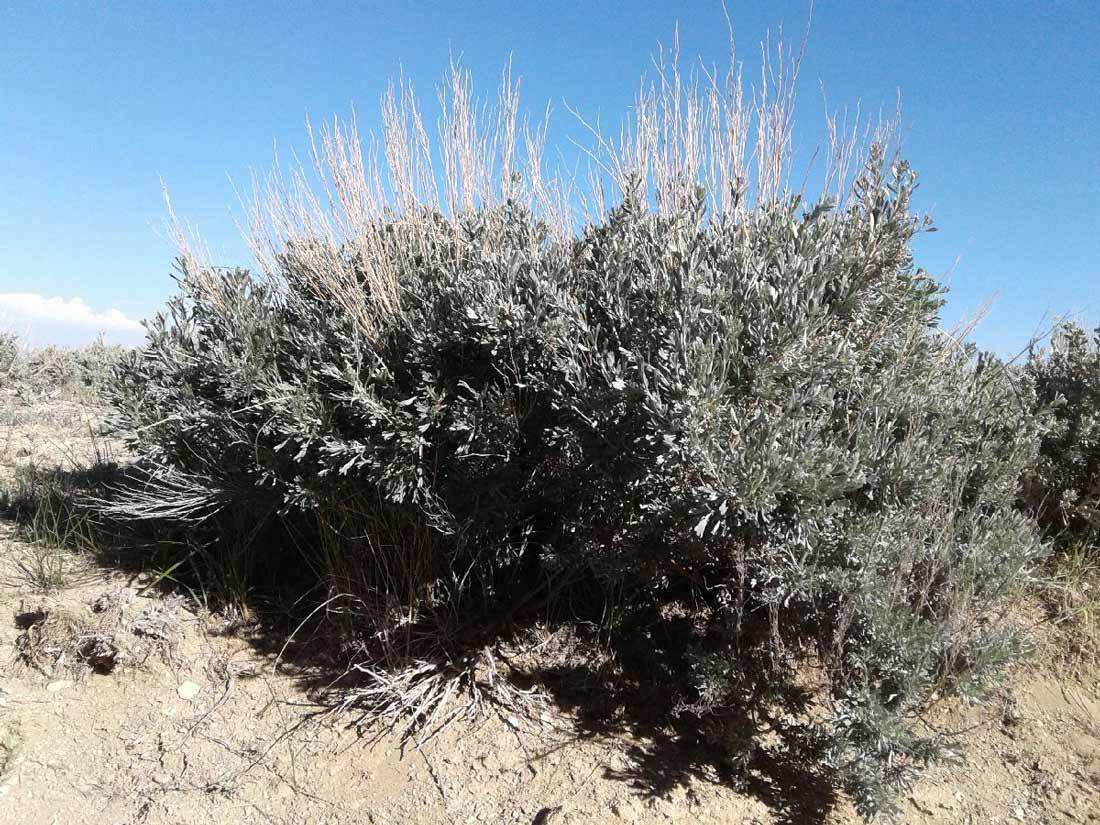Inter-Mountain Basins Big Sagebrush Shrubland
Lookout Mountain, Moffat County
Inter mountain Basins Big Sagebrush Shrublands
In the Semi-desert Shrubland ecozone, Big Sagebrush shrublands are one of the most common plant communities, and are common throughout the western United States. In Colorado this plant community occurs from 4,000 to 6,500’ elevation west of the Rocky Mountains primarily in broad basins and foothills between the high plateaus and mountain ranges.
Whereas the montane, subalpine and alpine ecozones are quite similar on the eastern and western slope of Colorado, the lower areas between 4,000 and 6,500 feet are very different. So why don’t the western great plains grasslands occur on the western slope? The primary reason for this is that the western slope areas at this altitude are drier than the great plains, receiving 10-15 inches of rain per year, rather than the 15-20 on the eastern plains. In addition to this, whereas the western great plains receive 75% of their moisture during their May through June growing season, the western slope areas only receive half (52%) of their moisture during this period. Their highest moisture months are July, August and September resulting in drier conditions in any point during the year.
As is true on the eastern slope, annual precipitation increases with increases in elevation and so grasslands on the western slope do not appear until above 7,000 feet.
As a result of this climate, the plants that one finds here are those that are best adapted for semi-desert conditions, namely one of the three subspecies of Big Sagebrush (Artemesia tridentata). Depending on subtle differences in soils and environmental conditions one will find either Basin Big Sagebrush (Artemisia tridentata subsp. tridentata), Mountain Big Sagebrush (Artemisia tridentata var. vaseyana) or Wyoming Big Sagebrush (Artemisia tridentata subsp. wyomingensis) as a major component of these shrublands.
Big Sagebrush has a unique root structure which is perfectly adapted to the precipitation patterns of western Colorado, which has moderate moisture from snowpack in winter, intense bursts of rain from thunderstorms in the summer, and extended periods of drought. The root structure of these shrubs include wide-spreading surface roots to capture the short intense rains, and a long taproot averaging 12 feet (up to 20 feet in ideal soil conditions) to capture the moisture deep in the soil absorbed from the winter snowpack. Big Sagebrush is limited on the eastern great plains due to the relative lack of moisture in the winter which big sagebrush needs to recharge the moisture in the deep soils, and the relatively more moisture in the summer which favors grasses.
Some Commonly Associated Plants
Click on photo to see full-page lightbox image.
In lightbox, click on X in upper right corner to return here.
Vasey's Sagebrush (Artemisia tridentata var. vaseyana)
Vasey's Sagebrush (Artemisia tridentata var. vaseyana), Aster Family (Asteraceae), native, common and widespread. One of three varieties of Artemisia tridentata which occurs in higher, (foothills) and more moist areas than var. wyomingensis. It is distinguished from var. wyomingensis by being mostly flat-topped or rounded with the inflorescence arising at the same height. Its leaves have a sweet camphor-like odor when crushed. Photo by Mo Ewing.
The most drought tolerant subspecies of Big Sagebrush is subspecies wyomingensis. It occurs from 4,040 to 8.700 feet altitude in areas that are often windy and exposed, and receive 7-12 inches of precipitation per year. In areas that have less than seven inches of precipitation per year, it grades into salt desert shrub communities dominated by shadscale (Atriplex confertifolia), saltbush (Atriplex canescens) and winterfat (Krascheninnikovia lanata). In areas with greater than 12 inches of precipitation per year, the plant community grades into Mountain Big Sagebrush (subsp. vaseyana), and pinyon-juniper woodlands. Basin big sagebrush (subsp. tridentata) falls roughly between Wyoming big sage and mountain big sage in terms of its need for annual moisture and winter snowpack.
All subspecies of big sagebrush grow on well-drained soils and cannot tolerate saturated soils. In fact they cannot grow in areas with high water tables at all.
Associated species vary with variations in topography, soil temperature and moisture regimes. Species diversity is higher in mountain big sage communities where there are lower temperatures and higher moisture than it is in Wyoming big sage communities, but the number of species present in both communities vary from year to year due to fluctuations in precipitation.
Other shrubs found in these communities are scattered Juniper species, Atriplex species, rabbitbrush (Ericameria nauseosa), greasewood (Sarcobatus vermiculatus), and antelope bitterbrush (Purshia tridentata).
Graminoid species may include blue grama (Bouteloua gracilis), needle and thread (Hesperostipa comata), western wheatgrass (Pascopyrum smithii), one-sided bluegrass (Poa secunda), or bluebunch wheatgrass (Pseudoroegneria spicata).
Some common forb species include, milkvetch (Astragalus spp.), pussytoes (Antennaria spp.), phlox (Phlox spp.), fleabane (Erigeron spp.), arrowleaf balsamroot (Balsamorhiza sagittata), lupine, (Lupinus spp.) and globemallow (Sphaeralcea spp.).
– Mo Ewing
Citations & More Reading
Citations and More Reading
Natureserve.org,Great Basin Intermountain Tall Sagebrush Steppe and Shrubland
Climatology and Vegetation in Colorado, W. W. Robins, Botanical Gazette, Vol. 49 No. 4 (Apr 1910, pp 256-260, University of Chicago Press
Innes, Robin J. 2019. Artemisia tridentata subsp. wyomingensis, Wyoming big sagebrush. In: Fire Effects Information System, [Online]. U.S. Department of Agriculture, Forest Service, Rocky Mountain Research Station, Missoula Fire Sciences Laboratory (Producer).
Available: https://www.fs.fed.us/database/feis/plants/shrub/arttriw/all.html

